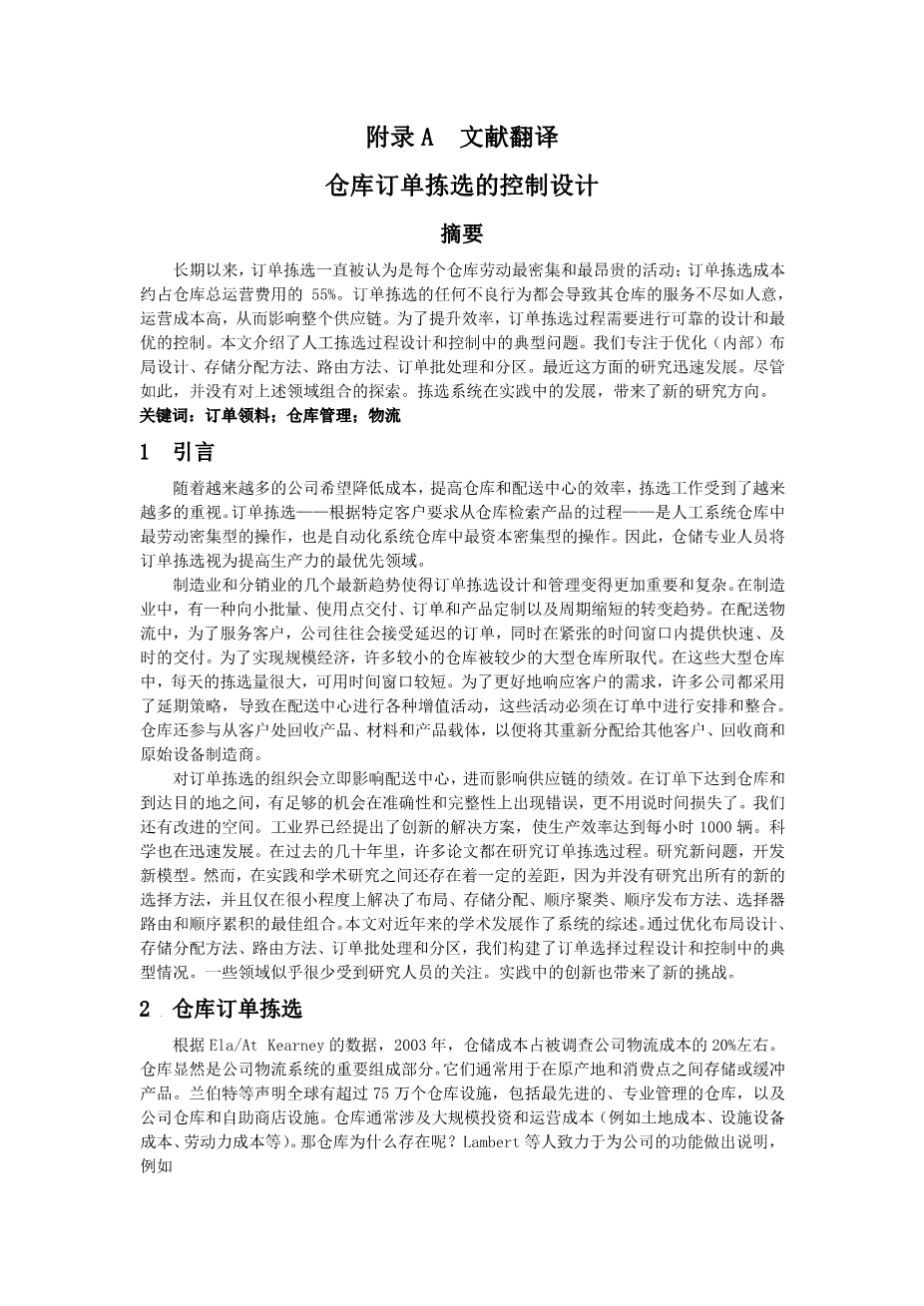Design and control of warehouse order picking
Abstract: Order picking has long been identified as the most labour-intensive and costly activity for almost every warehouse; the cost of order picking is estimated to be as much as 55% of the total warehouse operating expense. Any underperformance in order picking can lead to unsatisfactory service and high operational cost for its warehouse, and consequently for the whole supply chain. In order to operate efficiently, the orderpicking process needs to be robustly designed and optimally controlled. This paper gives a literature overview on typical decision problems in design and control of manual order-picking processes. We focus on optimal (internal) layout design, storage assignment methods, routing methods, order batching and zoning. The research in this area has grown rapidly recently. Still, combinations of the above areas have hardly been explored. Order-picking system developments in practice lead to promising new research directions.
Keywords: Order picking; Warehouse management; Logistics
1 Introduction
As more companies look to cut costs and improve productivity within their warehouses and distribution centres, picking has come under increased scrutiny. Order picking - the process of retrieving products from storage in response to a specific customer request - is the most labour-intensive operation in warehouses with manual systems, and a very capital-intensive operation in warehouses with automated systems. For these reasons, warehousing professionals consider order picking as the highest-priority area for productivity improvements.
Several recent trends both in manufacturing and distribution have made the order-picking design and management become more important and complex. In manufacturing, there is a move to smaller lot-sizes, point-of-use delivery, order and product customisation, and cycle time reductions. In distribution logistics, in order to serve customers, companies tend to accept late orders while providing rapid and timely delivery within tight time windows. Many smaller warehouses are being replaced by fewer large warehouses to realise economies of scale. In these large warehouses, the daily pick volume is large and the available time window is short. In order to be more responsive to customers, many companies have adopted a postponement strategy leading to various value-adding activities that take place in the distribution center and which have to be scheduled and integrated in the order-picking process. Warehouses are also involved in recovering products, materials, and product carriers from customers in order to redistribute them to other customers, recyclers, and original-equipment manufacturers
The organization of order-picking operations immediately impacts the distribution centrersquo;s and thereby the supply chainrsquo;s performance. Between the time an order is released to the warehouse and the time it takes to reach its destination, there is ample opportunity for errors in both accuracy and completeness, not to mention time lost. There is also room for improvement. Industry has come up with innovative solutions, making it possible to attain productivity up to 1,000 picks per person hour. Science is also progressing rapidly. Over the last decades, many papers have appeared studying order picking processes. New problems have been studied and new models have been developed. Still, there is a gap between practice and academic research, since not all new picking methods have been studied and the optimal combinations of layout, storage assignment, order clustering, order release method, picker routing and order accumulation have been addressed to a minor extent only. This paper presents a systematic overview of these recent developments in academic literature. We structure typical decision problems in design and control of order-picking processes by focusing on optimal layout design, storage assignment methods, routing methods, order batching, and zoning. Several areas appear to have received only little attention from researchers. Innovations from practice also lead to new research challenges.
2 Warehouses and order picking
According to ELA/AT Kearney, warehousing contributed to about 20% of the surveyed companiesrsquo; logistics costs in 2003. Warehouses apparently form an important part of a firmrsquo;s logistics system. They are commonly used for storing or buffering products at and between points of origin and points of consumption. Lambert et al. state that more than 750,000 warehouse facilities exist worldwide, including state-of-art, professionally managed warehouses, as well as company stockrooms and self-store facilities. Warehouses often involve large investments and operating costs (e.g. cost of land, facility equipment, labour hellip;). So, why do warehouses exist? According to Lambert et al. they contribute to a multitude of the companyrsquo;s missions, like
- Achieving transportation economies (e.g. combine shipment, full-container load).
- Achieving production economies (e.g. make-to-stock production policy).
- Taking advantage of quality purchase discounts and forward buys.
- Supporting the firmrsquo;s customer service policies.
- Meeting changing market conditions and uncertainties. Overcoming the time and space differences that exist between producers and customers.
- Accomplishing least total cost logistics commensurate with a desired level of customer service.
- Supporting the just-in-time programs of suppliers and customers.
- Providing customers with a mix of products instead of a single product on each order Providing temporary storage of material to be disposed or recycled (i.e. reverse logistics).
- Providing a buffer location for trans-shipments (i.e. direct delivery, cross-docking).
<p
全文共39903字,剩余内容已隐藏,支付完成后下载完整资料</p

英语译文共 26 页,剩余内容已隐藏,支付完成后下载完整资料
资料编号:[453559],资料为PDF文档或Word文档,PDF文档可免费转换为Word


